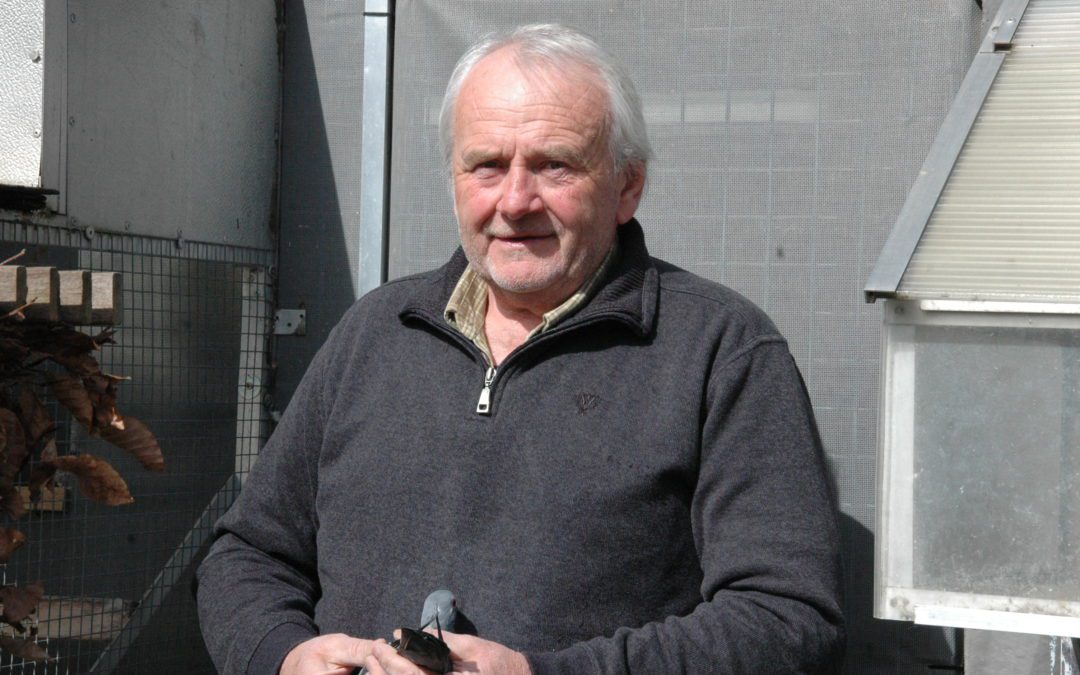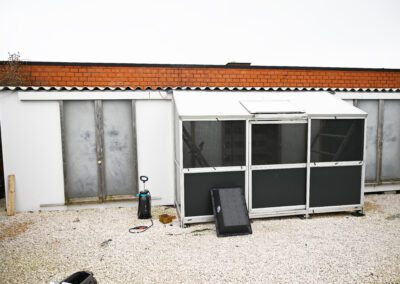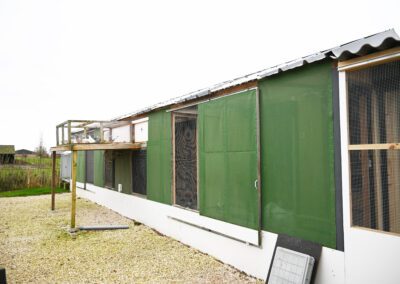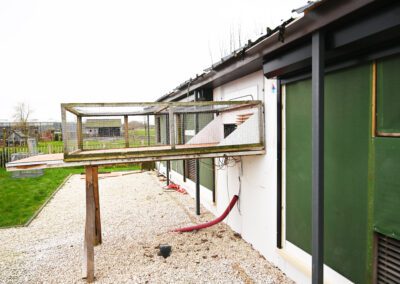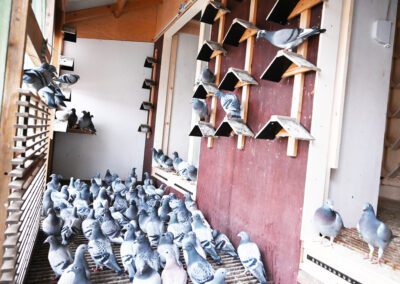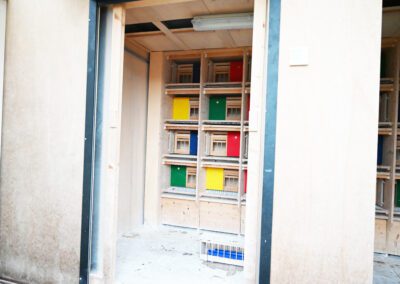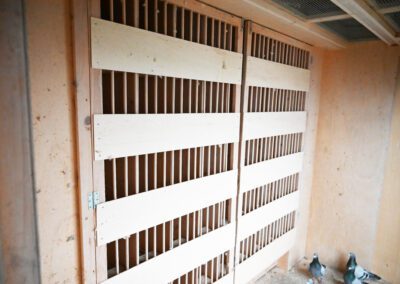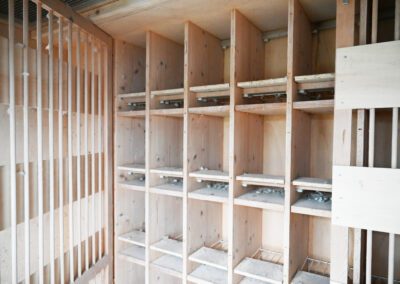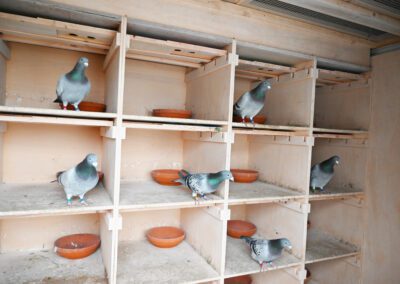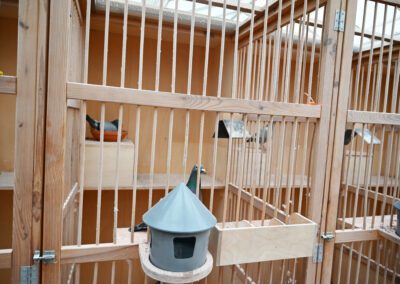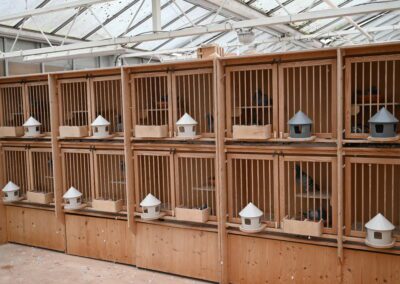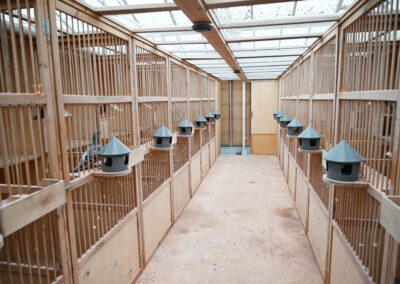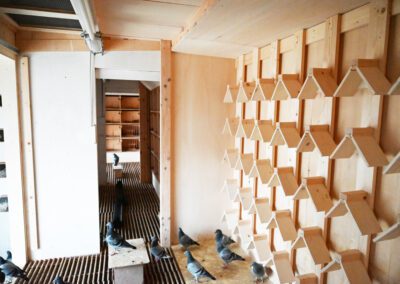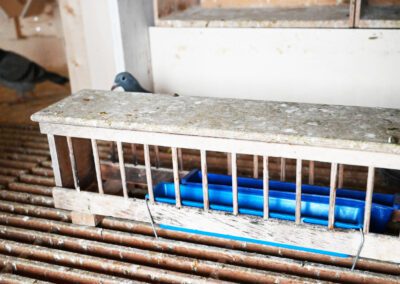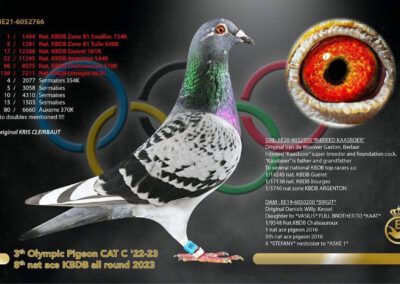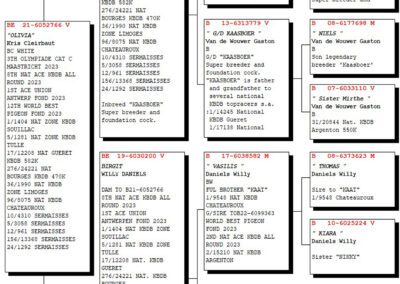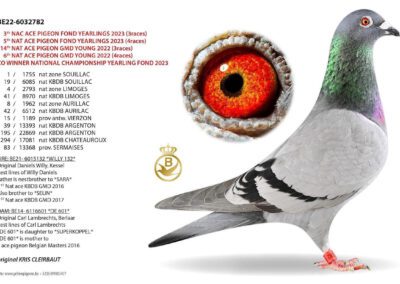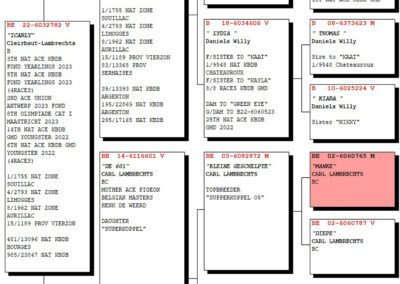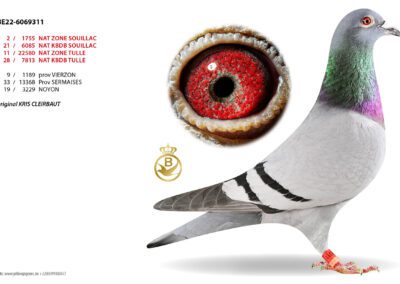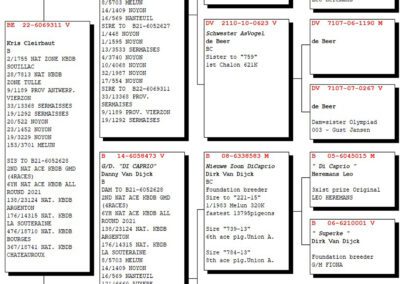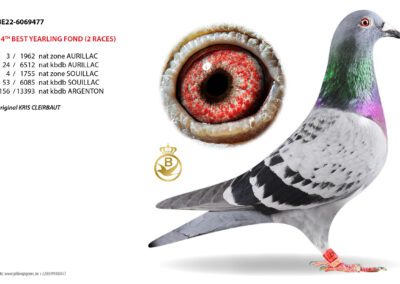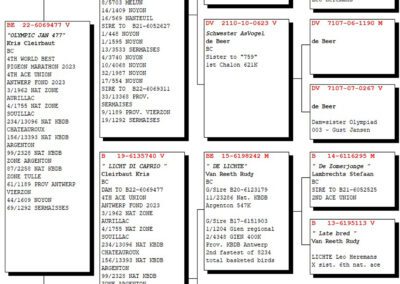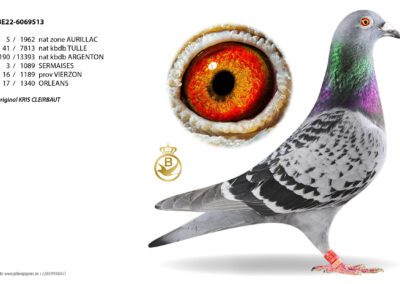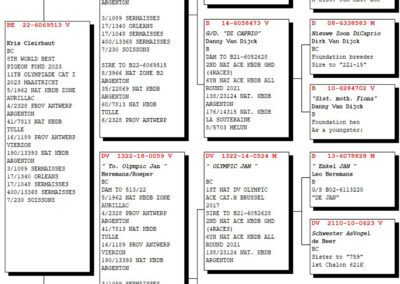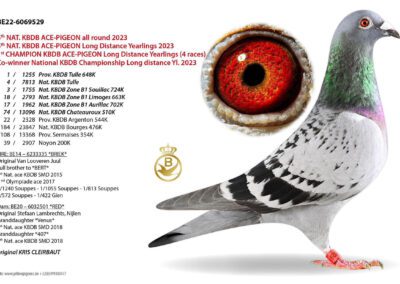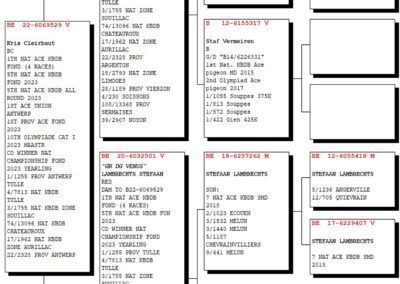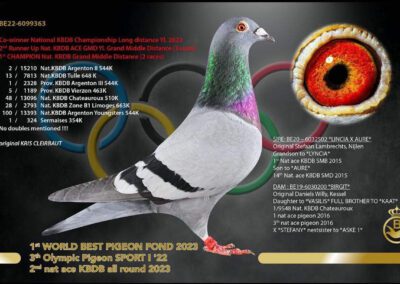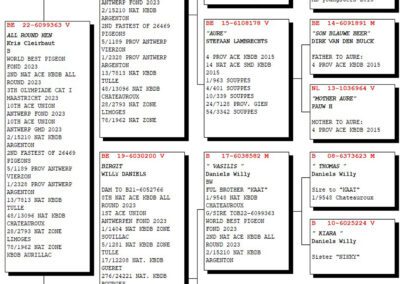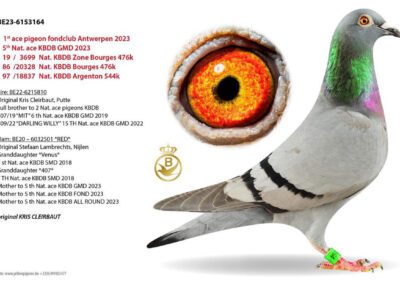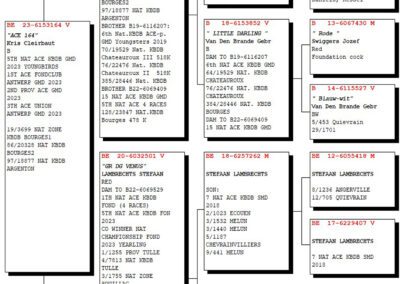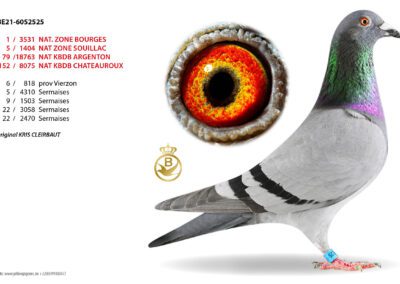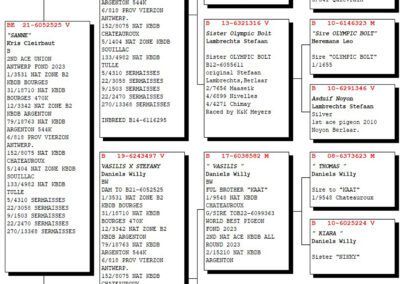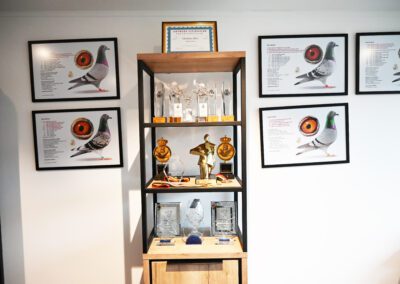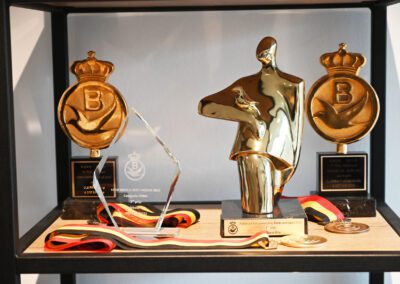For this report we visit Dirk Dedobbeleer. Thanks to the unique performance of his hen “Rose”, Dirk could stand on the highest platform during the celebration of the national champions KBDB 2021. Winning a national ace pigeon is the dream of every pigeon fancier and Dirk enjoys this experience to the fullest.
1st National ace KBDB “Rose” B20/2039874
And now comes a nice anecdote. National ace bird “Rose” was not born on the lofts of Dirk but was bought on the well-known pigeon market in Lier. Dirk tells: “In fact a short story but with a long history. At the end of the 80’s we were sitting in the pigeon club and suddenly 5 English pigeon fanciers entered. In poor English and a lot of gestures we conversated with our new friend and one day later we were on the road with these men to Lier to buy pigeons on the market. Those English fanciers bought baskets full of youngsters. Everyone was satisfied and for about 10 years we made this annual trip together. Afterwards, we did not visit the pigeon market of Lier anymore but in the early 2000s, we went there together with some friends from the region. Sense the atmosphere, have a beer, and return home with some youngsters…that is also pigeon sport. And it may be said, I have bought some good pigeons there several times.
My best purchase was of course “Rose” in 2020. This hen was bought from Fabienne Peeters (Dirk Wouters). It was a friend of my son who insisted to visit this fancier on the market to buy some youngsters. A golden tip as it turns out now.
“Rose” is a middle-sized hen and softly feathered. She has closed ventbones and has a strong back. She has a short forearm and a perfect wing. Sometimes, she is a rather nervous pigeon. She has a perfect eye with a complete bandage and a strong color. Dirk attaches significant importance to the eye when judging a pigeon.
Whether “Rose” was specially motivated? Not really… when I coupled the pigeons at springtime, I left everybody hen free to choose a cock. Everyone was paired after a few days, except “Rose”. She just sat there looking at them and she was not interested in anything or anybody. It was striking that she always wanted to go to the loft next to it, where there were also pigeons paired. At one moment, she was faster than me and she slipped between my legs to the other loft. Unbelievable but immediately she flew dragging her tail into the box of a pigeon that was not paired yet. Has that been her motivation to perform top during the whole season? Who will say.
“Rose” became national KBDB ace bird with following performances:
3 Sermaises (300km) 1674 yearbirds
8 Sermaises 3353 old + yearbirds
9 Sermaises 2705 old + yearbirds
3 Sermaises 1770 old + yearbirds
1 Sermaise 295 yearbirds
How it all started
Dirk, 63 years old, was born and raised in Vollezele. He was an insurance broker there and he also ran a bank branch. He lived in Vollezele from 1959 till 2016 and then he moved to Herne. Father Adolf was a pigeon fancier and his uncles, on his mother’s side, were also pigeon fanciers. So, Dirk was born in a fancier’s nest and from the age of 12 he was constantly busy with pigeons. Father had a busy life and got less and less time for his pigeons. For that reason, he started to race together with his neighbor. Most of the pigeons of father were housed by his neighbor except for four pigeons that were not moved. Dirk continued racing with these pigeons and from another neighbor he got two hens. He crossed them with the four pigeons that stayed behind, and Dirk was again fancier. He raced the sprint, and the young hens were raced on the middle distance. In the meantime, also pigeons of local stars were added.
In 2016 the move to Herne took place and the best pigeons from Vollezelle also moved to Herne. Then they looked for reinforcement at Winy and Guy Nelissen, Genk where they bought eight pigeons and with two hens he succeeded very well. Also, at the combination Nechelput-Cornet, Kester three pigeons were bought, and these are very promising. From Geert De Schepper, Gooik twenty pigeons were bought (since 2018) for the long-distance races. Geert is a topper who has success with a limited number of pigeons in long-distance races. Also at Twan Bongers, Odiliapeel (Nl) about seven pigeons were bought and they were crossed with the De Schepper pigeons. You can see that the intention is to go more and more in the direction of long distance. Not that we say goodbye to the speed- and middle-distance, but the call to try the marathon is getting bigger and bigger. Also fixed on the breeding loft is an excellent breeding hen of Jos De Belder, Sint-Katelijne-Waver. Through internet purchases on the Herbots website the GB 17-Z-067184 “New Bliksem 84” was bought. It is a one hundred percent Gaby Vandenabeele pigeon out of an inbreeding coupling to “New Bliksem”. Another acquisition was the B16/2024310 “Daughter Olympic Way”, origin Erik Limbourg.
The 23 breeders were coupled around Christmas and last time all pigeons were recoupled. Dirk especially looks at the eyes when he pairs them. In the first place a pigeon has to have a strong eye. Only pigeons with different colored eyes are being coupled. A breeder has to give results within two years, or he has to leave. In that period the cock gets four different hens.
22 pair on total widowhood
There were 22 couples raced on total widowhood. The 10 pairs for the short distance bred early (coupled end December). The pigeons for the great middle-distance races only had eight days of eggs. The hens were raced on Quiévrain (40km), the cocks and some hens were raced on Noyon (150km) and the small middle distance (300km). There was also a team of cocks and hens raced on the great middle distance (400km – 500km).
The pigeons train twice a day around the loft. After a few training tosses, the old birds were basketed 3 times for Quiévrain. The yearlings were tossed 6 times and then they went to Quiévrain and so further to the middle or great middle-distance races. They were raced on the sliding door system, just as the youngsters. When basketing, cocks and hens came together for an hour. After arrival of a race, they stayed together till the next day. The cocks were housed on two identical lofts. When Dirk was looking for some extra motivation, the door between both lofts was opened and cocks flew back and forth. Most of the pigeons wanted to conquer a box on the other loft and then you have to stay close as a fancier to avoid accidents. After the end of the racing season, a round of late youngsters was also bred.
Young birds
40 early bred youngsters and 45 summer youngsters were bred and weaned at the age of 25 days. Young cocks and hens were put separately from weaning. With a few corrections, this worked out perfectly. The youngsters were not darkened and not given extra light. The youngsters were trained in 6 stages and then they went straight to Quiévrain. The early round went directly to Noyon. In between they were not taken away. To motivate the youngsters, we put some trays and cardboard boxes on the loft. When basketing, the young cocks and hens came together for about 4 hours. After the arrival of a race, the youngsters stayed together till the next morning. Because of the hospitalization of Dirk, the youngsters were treated a bit poorly during the past season.
Dirk about the selection: “The racers are expected to fly 4x in the first 10% on 10 races. Of course, top prizes are expected because I am a “gambler”! As far as the model of a pigeon is concerned, I do not prefer too big pigeons. They have to be well made and they have to fit in the hand. The model is important”.
Feeding
Dirk puts his trust in the Vandenabeele mixture (Beyers) and Plus I.C.+ mutine and Plus I.C.+ start of Versele Laga or the well-known moulting and breeding mixture. After returning from the sprints and the middle-distance, on Sunday and Monday, they get the Vandenabeele mixture + moulting mix. On Tuesday and Wednesday, the Vandenabeele mixture is fed. On Thursday, we feed them moulting mixture. On Friday, we feed moulting mixture + fine seeds (rich in fat). On Saturday, a bit of Vandenabeele mixture. After returning from the great middle distance, on Saturday and Sunday, we feed them Vandenabeele mixture + moulting mixture. On Monday and Tuesday, the Vandenabeele mixture goes into the feeder. On Wednesday and Thursday, the moulting mixture is mixed with some fine seeds (rich in fat). At the arrival of a race, there are electrolytes in the drinker. At the beginning of the week, vitamins are added to the feed. With heavy weather forecasted on the longer distance’s races, Carbosol is added to the drinker.
Medical guidance
Dirk only goes to the vet for the obliged inoculations. At the beginning of the racing season the pigeons get ¼ pill Flagyl. Further on during the racing season the racers get ¼ pill Flagyl every three weeks. Three days a week, the pigeons get “Bio-Even” in the drinking water and that is particularly good against trichomonas. Naturaline from Natural is also provided. Against the respiratory infections nothing is done. A good ventilation and less pigeons in the loft will solve this problem. Dirk has known a lot of problems with adeno but the last few years they have become a lot less. Against paramyxo, they vaccinate 1x or 2x with the normal vaccine. Against paratyphoid, Baytril is given for 10 to 12 days at the end of the season. There is no vaccination.
The loft construction
The old and young pigeons are raced on 12 m lofts. The ventilation takes place through two metal doors (bottom grids like in an aviary) that are covered with windbreak netting in the front of the loft. This ventilation takes place in winter and summer. The sputniks are closed on the inside. On the front side of the lofts there are three aviaries. The walls of the lofts are made with the classic cement plates. Against this came a 4 cm insulation and the inside was finished with wooden boards. The lofts of the old pigeons are cleaned once a day. The young pigeons usually get granules or straw on the bottom. The boxes are cleaned daily. There is little glass in the lofts.
In 2021 the bottom of the loft consisted of grids. As of 2022, it will be a plank floor again. The pigeons spill some grain that falls through the grids and soon there is the problem of mice.
Some other toppers
B17/2141182: 6th Quiévrain 366b, 8th Quiévrain 307b, 6th Quiévrain 177b, 25th Quiévrain 159b, 17th Quiévrain 151b, 6th Quiévrain 226b, 15th Quiévrain 188b, 5th Quiévrain 114b, 8th Quiévrain 114b, 15th Quiévrain 92b, 2nd Quiévrain 80b, 6th Quiévrain 155b, 2nd Quiévrain 105b, 1st Quiévrain 42b, 1st Quiévrain 80b, 32nd Quiévrain 161b, 9th Quiévrain 114b, 1st Quiévrain 80b, 1st Quiévrain 115b, 4th Quiévrain 91b, 5th Quiévrain 71b, 6th Quiévrain 123b, 7th Quiévrain 102b, 5th Quiévrain 126b, 11th Quiévrain 118b, 26th Quiévrain 179b, 12th Quiévrain 119b, 12th Quiévrain 114b.
B17-2146261 “Goeden Blauwen” 1st Noyon 68b. 1st Noyon 44b. 2nd Noyon 107b. 3rd Noyon 206b. 3rd Noyon 193b. 3rd Noyon 181b. 4th Quievrain 84b. 5th Noyon 291b. 5th Noyon 101b.
B20-2035231 “Witteken”: 4th Sermaises Pajot 1902b. 6th combine 3353b. 1st club 480b. 11th Sermaises 663b. 27th combine 1139b. 18e Sermaises 1541b. 31e combine 2705b. 61st Sermaises 1674b. 99th combine 2774b. – 4th Noyon 208b. 7th Noyon 396b. 17th Noyon 408b. 22e Noyon 277b
